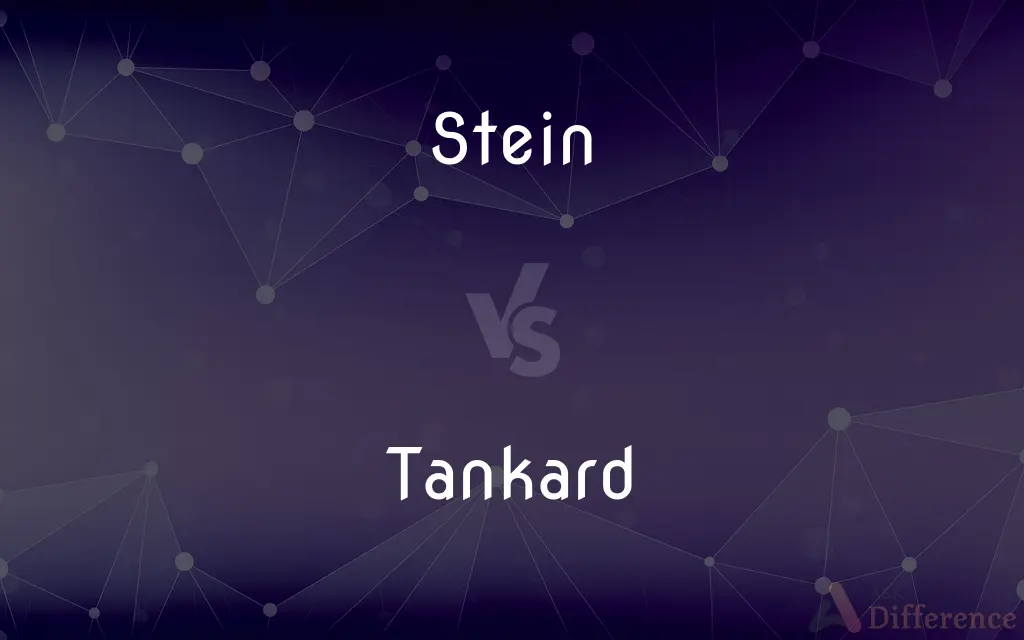Stein vs. Tankard — What's the Difference?
By Tayyaba Rehman — Updated on October 6, 2023
A "Stein" is a beer mug, often ornate, originating from Germany, while a "Tankard" is a large drinking cup, usually with a handle, made of various materials. Both are designed for holding and consuming beverages.

Difference Between Stein and Tankard
Table of Contents
ADVERTISEMENT
Key Differences
A "Stein" specifically refers to a beer mug that has its roots in Germany. They are often made of stoneware and can be quite decorative, featuring various designs, images, or even scenes. Many Steins come with a hinged lid. "Tankard," in contrast, is a broader term that encompasses large drinking vessels typically with a handle. While it can be used for beer, it isn't exclusive to it.
The decorative nature of many "Steins" makes them collector's items. People not only use them for drinking but also display them as part of their home or pub decor. "Tankards" can be decorative too but are generally more functional in design, emphasizing utility over ornamentation.
"Steins" are often associated with traditional German events and festivals, such as Oktoberfest. When one thinks of a Stein, images of large mugs filled with beer, raised in toast during lively celebrations, come to mind. "Tankards," on the other hand, have a more widespread history and usage, found in various cultures worldwide.
Both "Steins" and "Tankards" have their place in history. While the Stein is culturally significant to Germany, the Tankard's presence can be traced back to ancient civilizations, where it was made from materials like wood, glass, or even pewter.
Comparison Chart
Origin/Association
German in origin.
Broadly used in various cultures.
ADVERTISEMENT
Material
Often made of stoneware.
Made from various materials like pewter, glass, or wood.
Usage
Primarily for beer.
Used for various beverages.
Design
Often decorative and might have a hinged lid.
Generally functional, some can be ornate.
Cultural Significance
Associated with German festivals like Oktoberfest.
Found in many ancient and modern cultures.
Compare with Definitions
Stein
A mug associated with festivals like Oktoberfest.
Every year, he bought a new Stein from the Oktoberfest.
Tankard
A vessel, often made of pewter or silver.
The silver Tankard shimmered in the light.
Stein
A container for beverages, especially beer.
The intricately designed Stein caught her eye.
Tankard
A common drinking tool in pubs and taverns.
He ordered a Tankard of the house ale.
Stein
A drinking vessel, typically with a hinged lid.
The old Stein on the shelf was a family heirloom.
Tankard
A large cup or mug with a handle for drinking.
He drank from the Tankard with gusto.
Stein
A German beer mug, often ornate.
He lifted his Stein to propose a toast.
Tankard
A drinking apparatus with historical significance.
Ancient Tankards were often carved from wood.
Stein
A collectible item, often showcasing German culture.
His collection of Steins from various regions was impressive.
Tankard
A container for various beverages, not just beer.
The cold cider in the Tankard was refreshing.
Stein
A large earthenware beer mug.
Tankard
A tankard is a form of drinkware consisting of a large, roughly cylindrical, drinking cup with a single handle. Tankards are usually made of silver or pewter, but can be made of other materials, for example wood, ceramic or leather.
Stein
Variant spelling of steen
Tankard
A tall beer mug, typically made of silver or pewter, with a handle and sometimes a hinged lid.
Stein
A beer mug, especially one that is large or decorated.
Tankard
A large drinking cup having a single handle and often a hinged cover, especially a tall pewter or silver mug.
Stein
A beer mug, usually made of ceramic or glass.
Tankard
A large drinking vessel, sometimes of pewter, sometimes with a glass base, with one handle and often a hinged cover.Tankard
I sure would be much happier with a tankard of mead right about now.
Stein
See Steen.
Tankard
A large drinking vessel, especially one with a cover.
Marius was the first who drank out of a silver tankard, after the manner of Bacchus.
Stein
A mug intended for serving beer
Tankard
Large drinking vessel with one handle
Stein
Experimental expatriate United States writer (1874-1946)
Common Curiosities
Are all Tankards made of metal?
No, Tankards can be made of various materials including pewter, wood, and glass.
Is every Stein decorative?
While many Steins are ornate, not all are decorative. Some are simple and functional.
Is a Stein specific to any culture?
Yes, Steins are closely associated with German culture and traditions.
Can a Tankard have a lid?
Yes, some Tankards come with lids, though it's more common with Steins.
Is it common for a Stein to have a hinged lid?
Yes, many traditional Steins come with hinged lids, though not all.
Can you drink beverages other than beer from a Stein?
While Steins are primarily for beer, they can hold other beverages too.
Are Tankards collectible like Steins?
Yes, certain Tankards, especially those made of valuable materials or with historical significance, are collectible.
What is the primary use of a Stein?
A Stein is primarily used for drinking beer, especially in German contexts.
What events commonly feature Steins?
Events like Oktoberfest and other German festivals often feature Steins.
Are there modern versions of Tankards?
Yes, while Tankards have historical roots, they are still used and produced in modern designs today.
Share Your Discovery

Previous Comparison
Release vs. Liberation
Next Comparison
Assistant vs. CoordinatorAuthor Spotlight
Written by
Tayyaba RehmanTayyaba Rehman is a distinguished writer, currently serving as a primary contributor to askdifference.com. As a researcher in semantics and etymology, Tayyaba's passion for the complexity of languages and their distinctions has found a perfect home on the platform. Tayyaba delves into the intricacies of language, distinguishing between commonly confused words and phrases, thereby providing clarity for readers worldwide.














































